You’re not alone if you’ve ever struggled to grow traditional pumpkins in Florida’s blazing heat and sugar-sand soil. Green worms, mildew, and relentless vine borers wiped out some of the first squashes I planted after moving to Central Florida. But after some research, I discovered the answer growing right here in our backyard: the resilient and beloved Seminole Pumpkin.
This heirloom has deep roots in Florida’s history, cultivated by Indigenous peoples and early settlers for generations. It’s perfectly adapted to our subtropical climate, tolerating heat, humidity, and poor soil. The flavor is similar to butternut squash, but slightly sweeter, and the fruits store beautifully for months. You can use them in any recipe for pumpkin or winter squash, from soups to pies.
If you’re ready to grow a variety that not only survives but thrives in Florida’s challenging conditions, plus rewards you with beautiful, long-lasting fruit, then let’s dig into how to grow Seminole pumpkin!
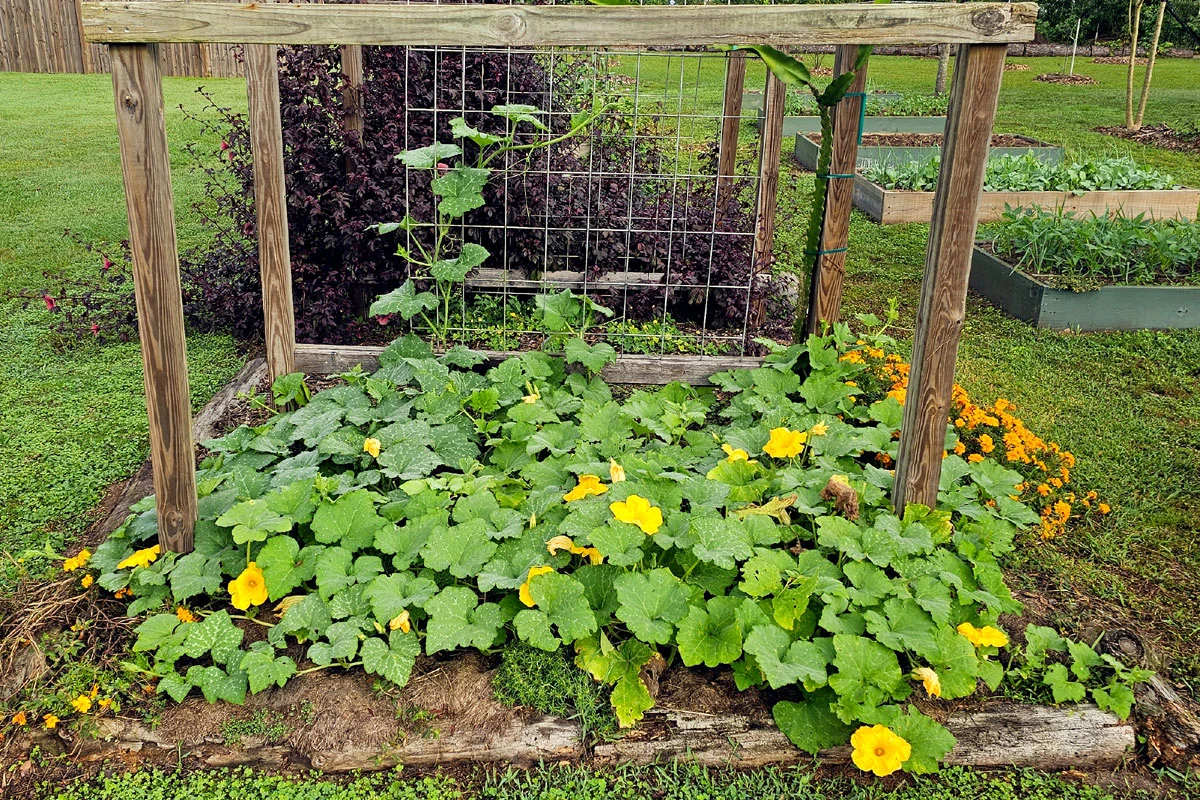
How to Grow Seminole Pumpkin
What We’ll Cover
- Why Grow Seminole Pumpkin?
- How to Prepare Your Soil
- Starting from Seeds or Seedlings
- Growing Guidelines
- Managing Pests and Diseases
- Harvest and Storage Tips
- You Can Grow This!
- Resources
- FAQs
Why Grow Seminole Pumpkin?
Seminole pumpkin is practically a gift to Floridian and Southern gardeners. This vigorous vine traces its roots back to the native peoples of Florida and was once grown extensively by the Seminole tribe. It’s well-adapted to heat, humidity, pests, and poor soil, making it a natural fit for USDA hardiness Zones 8–10.
You won’t need to choose among varieties for this one—Seminole pumpkin is the variety. Seek out heirloom or true-to-type seeds labeled “Seminole” to stay closest to the original strain.
While growing traditional pumpkins in Florida can be tricky, Seminole pumpkins make a lot more sense for food production in the home garden. It doesn’t just survive here—it’s naturally adapted to our climate. It grows vigorously, even in poor soil, and doesn’t need babying through the summer like so many other crops do.
If you’re looking for something dependable, productive, and beautiful on the vine, Seminole pumpkin earns its keep. It scrambles along fences, trellises, or the ground with ease and produces fruits that store well, taste great, and add a touch of tradition to your homestead.
A few reasons it’s worth planting:
- Thrives in less-than-ideal soil with just a bit of support.
- Holds up against common pests and summer stress.
- Long vines with wide leaves help shade out weeds.
- Perfect for pantry storage, these pumpkins keep well and stay flavorful.
- Great for gardeners in zones 8–10 looking to grow more with less fuss.
Once you’ve decided to give Seminole pumpkin a try, the next steps are choosing where to plant and making sure the soil can support its vigorous growth. This variety may tolerate poor conditions better than most, but giving it a strong start will still reward you with healthier vines and a bigger harvest.
How to Prepare Your Soil
Seminole pumpkin is a flexible grower—it can be planted directly in the ground, in raised beds, or even in large containers if needed. But like most crops, it’ll do best when the soil is well-prepared. In sandy soils (like much of Florida), adding organic matter helps retain moisture and nutrients. In heavier clay soils, loosening the soil and mixing in compost improves drainage and texture. No matter your starting point, a little prep work goes a long way toward a healthy harvest.
Before planting, mix in plenty of organic compost or well-aged manure to improve texture and fertility. If you have worm castings or homemade compost on hand, they’re excellent for boosting microbial life and giving your plants a strong start.
These vines like to spread out, so in-ground planting or large raised beds are usually the best option. No-dig beds can work beautifully, just be sure they’re well-fed with organic matter. Container growing isn’t ideal unless you’re using something very large (think 25 gallons or more), and you’ll still need to plan for the vines to climb or sprawl.
Starting from Seeds or Seedlings
Seminole pumpkins are typically grown from seed, and they germinate easily once the soil warms up. Direct sowing is often the simplest method, especially since these vigorous vines don’t love having their roots disturbed. That said, I’ve successfully started seedlings indoors and transplanted them with no trouble, as long as I handled them gently and moved them outside while still young. If you’d like a head start, sow seeds indoors about two weeks before your last frost date, and transplant once the seedlings have a few true leaves and the soil is consistently above 70°F.
When to Plant
Seminole pumpkins love the heat and need a long, frost-free growing season to thrive. Wait until soil temperatures stay consistently above 70°F for reliable germination. From planting to harvest takes about 95 to 120 days, so be sure to time your planting around your region’s frost dates.
- Zone 8: Start seeds indoors in March or direct sow in April through May.
- Zone 9: Direct sow as early as March; you can usually fit in a second crop in August.
- Zone 10: Sow anytime from February through September.
Plant seeds about 1 inch deep in mounded hills, leaving plenty of room for the vines to sprawl. These are strong growers, and once the weather warms, they’ll take off quickly.
Here in Zone 9, I wait until the soil warms up in March and sow directly into slightly raised mounds. I plant 6–8 seeds per hill, spacing the hills 2–3 feet apart. This gives the vines room to stretch and fruit before the peak of summer humidity. In late summer, I’ll start another patch, making sure to plant early enough so they mature before our first frost in December.
Whatever hardiness zone you live in, make sure you allow those 95 – 120 days without frost. These heat-loving vines will die quickly with the lightest of frosts.
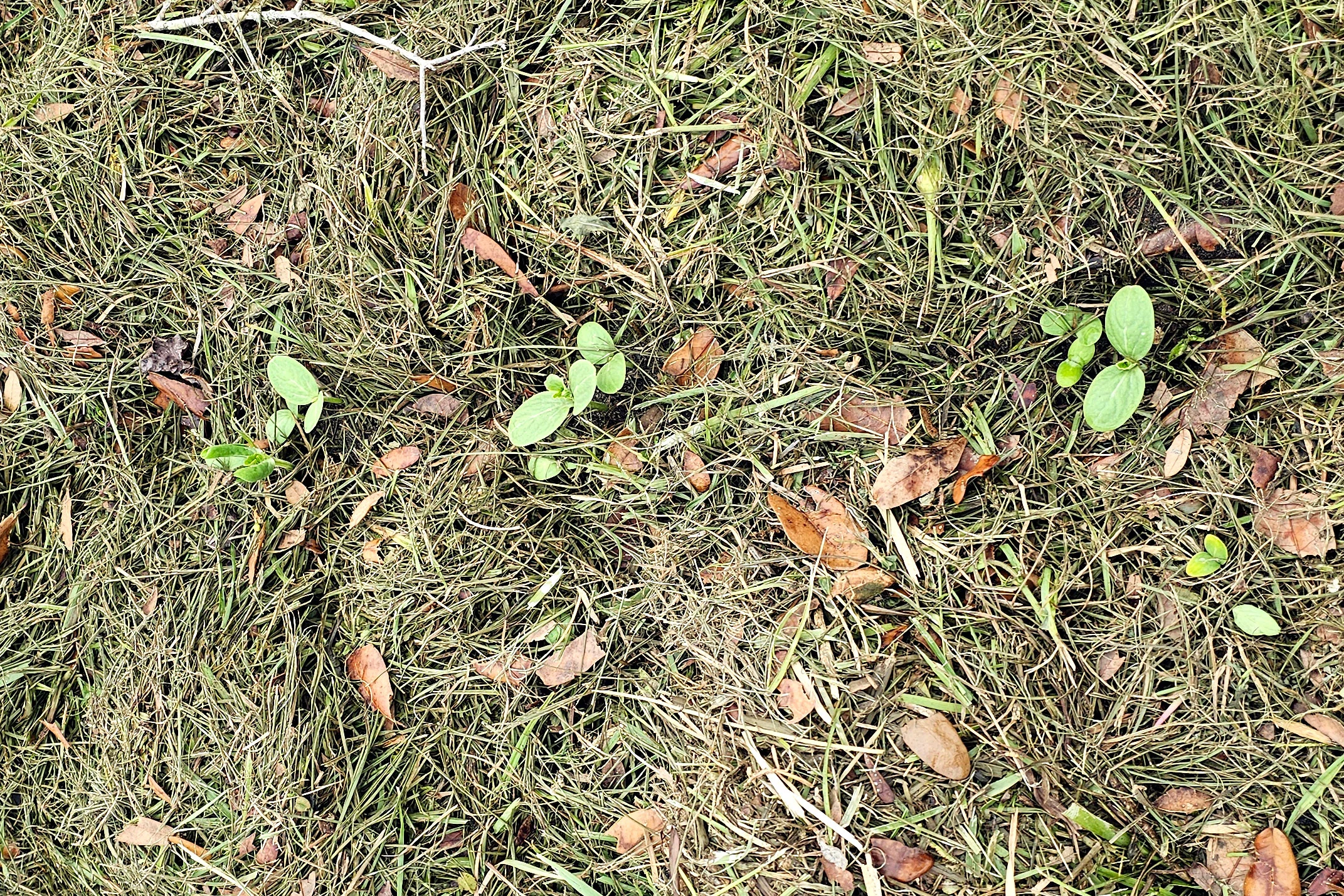
Growing Guidelines
Seminole pumpkin vines thrive in full sun and need plenty of space—expect them to stretch 10 to 20 feet or more! You can let them ramble across the ground, which helps shade out weeds and allows the vines to root at the nodes as they spread. These rooting nodes can draw in extra nutrients and moisture, helping the plant thrive even in tough conditions.
If you’re short on space, you can train the vines up a strong trellis or along a fence, but make sure it’s sturdy—these fruits can get heavy! I grow them on our cattle-panel arches. Sometimes I need to give the larger fruits a bit of extra support using a sling or melon cradle like this one from Bootstrap Farmer.
Seminole pumpkins produce both male and female flowers, and they rely on bees and other pollinators to set fruit. You’ll often see lots of male flowers open first. Once female flowers appear (they’re the ones with a tiny pumpkin at the base), pollination begins in earnest.
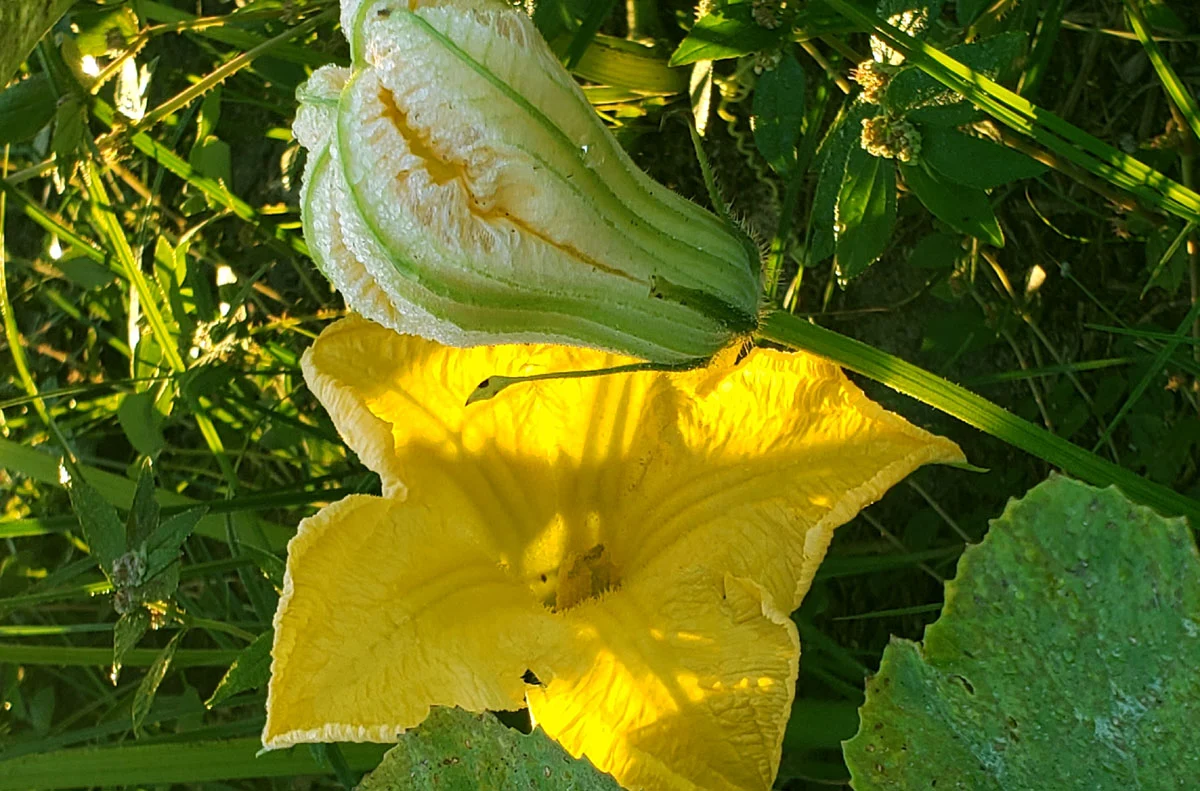
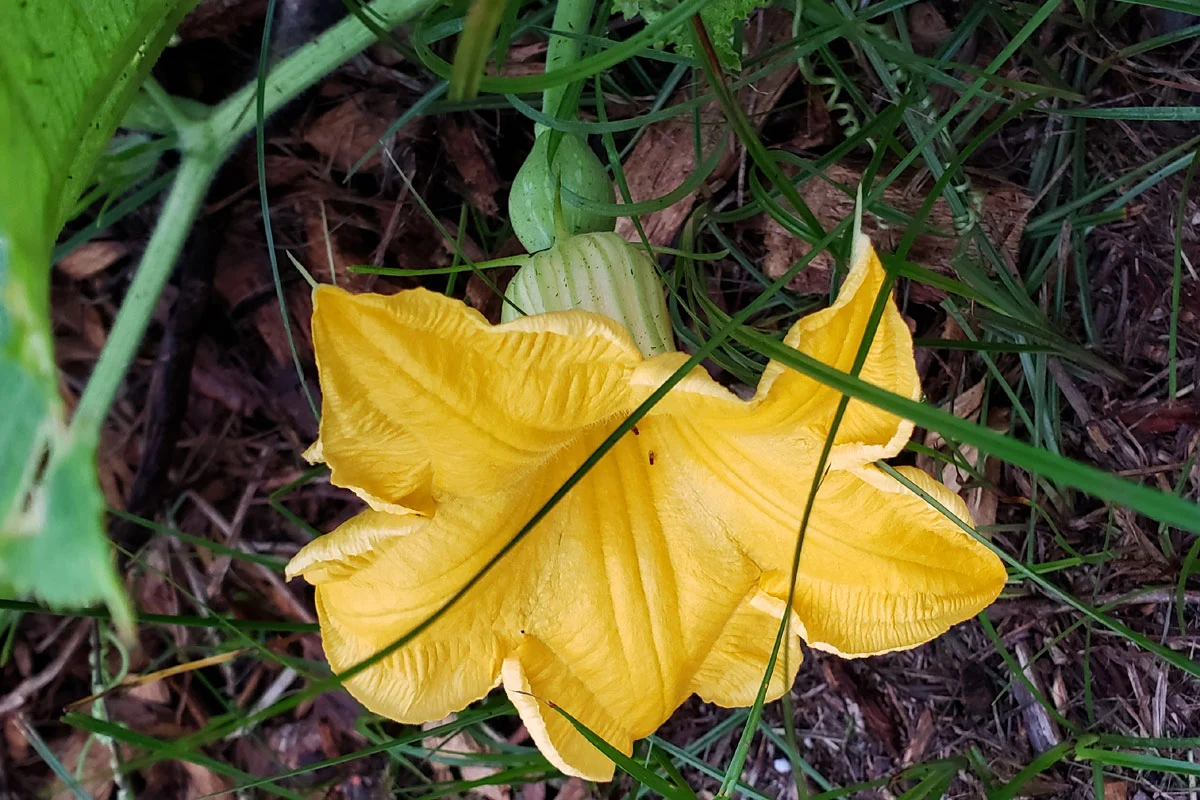
Growing Tips:
- Spacing: Sow seeds 3–4 feet apart in rows or mounds to give vines room to sprawl.
- Water: Water deeply at planting and while vines are getting established. Once they’re growing strong, Seminole pumpkins become fairly drought-tolerant, though they’ll do best with consistent moisture.
- Mulch: Apply a thick layer of mulch to help conserve water, suppress weeds, and keep the developing fruit off bare soil.
- Feeding: Feed every few weeks with compost tea or a balanced organic fertilizer until flowering starts. After that, the vines usually take off on their own.
Managing Pests and Diseases
Seminole pumpkin is one of the most pest and disease-resistant squash varieties you can grow in zones 8–10. Still, it’s smart to stay ahead of common problems with a few simple strategies.
You might run into:
- Squash vine borers – Less common with Seminole pumpkin, but still possible. Mound soil over vine nodes to encourage secondary roots, helping the plant survive any damage.
- Powdery mildew – Water at the base instead of overhead. Treat early with neem oil or a diluted milk spray (1 part milk to 9 parts water).
- Downy mildew – Common in Florida’s humid months. Improve airflow, avoid overhead watering, and treat with copper fungicide or organic sprays like potassium bicarbonate.
- Aphids or beetles – Handpick larger pests, use insecticidal soap or neem for small ones, and attract beneficial bugs with companion flowers.
Bonus Tip: Trellising or training vines along a fence helps with airflow and keeps leaves dry, which reduces the chance of fungal issues during rainy spells.
Harvesting and Storing
You’ll know your Seminole pumpkins are ready to harvest when the stems begin to dry out and the rinds harden. You shouldn’t be able to pierce the skin with a gentle push of your fingernail. The color should be tan or pale orange all around. Depending on when you planted and growing conditions, harvest usually falls between 90 and 120 days after sowing.
Harvest tips:
- Use clippers or garden pruners to cut the fruit from the vine, leaving 2–3 inches of stem attached. This helps prevent rot during storage.
- Cure the pumpkins in a warm, dry spot (like a shaded porch or shelf) for 10–14 days to harden the skin.
- Once cured, store in a cool, dry location—these pumpkins often last for several months without refrigeration.
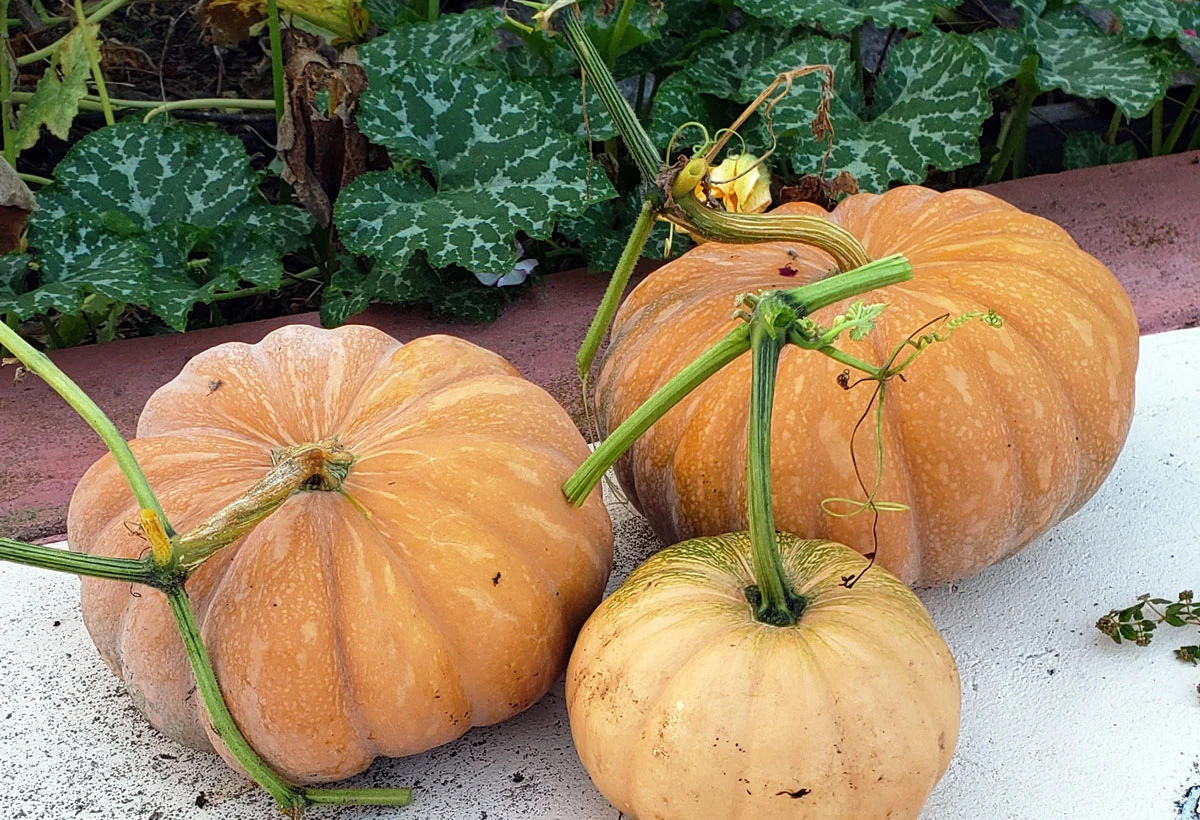
Saving Seeds for Next Season
Seminole pumpkins are open-pollinated, which means you can save seeds from fully mature fruits and expect them to grow true, as long as other squash varieties weren’t flowering nearby.
To save your seeds:
- Rinse them well to remove pulp, then dry thoroughly in a single layer. I
- Once completely dry, store in a labeled envelope or jar in a cool, dark place until planting season.
For more detailed tips on how to properly dry and store seeds, check out Seed Saving 101.
After the Harvest: Garden Cleanup
Once your vines have finished producing and started to die back, cut them at the base, leaving the roots to decay slowly to add tilth to your soil. Seminole pumpkin vines can be quite large, so it’s easiest to remove them in sections. Compost healthy vines if you have space, but avoid composting any plant parts with signs of disease or mildew. You can also lightly amend the bed with compost or a cover crop to prepare for your next season’s planting.
You Can Grow This!
If you’ve struggled with growing traditional pumpkins or squash in the Southeast, or here in subtropical Florida, don’t give up just yet—Seminole pumpkin is a tough, rewarding variety that naturally thrives in a hot and humid climate.
It’s low-maintenance, grows beautiful (and edible!) flowers, plus it’s an heirloom plant with deep roots in Florida’s agricultural traditions. With its strong resistance to pests, long storage life, and rich, sweet flavor, Seminole pumpkin brings both history and practicality to the garden.
I’d love to hear how it grows for you! Feel free to share your experience or questions in the comments below.
Resources
- History of the Seminole Pumpkin
- Attack of the Seminole Pumpkins
- UF IFAS Edible Plants – Seminole Pumpkin
- Florida Gardening Calendar
FAQs
Yes, Seminole pumpkins can cross with other C. moschata varieties (like butternut squash) if they flower at the same time. If you’re saving seeds, grow online one moschata variety at a time or isolate blooms to hand-pollinate.
The pumpkin is ready to harvest when the stem begins to dry, and the rind feels hard to the touch. Their color should be a light tan or muted orange all over.
A healthy vine can produce 4 – 10 pumpkins, depending on growing conditions, spacing, and pollination success. These vines are prolific when given room and nutrients.
They’ll thrive in rich, well-prepared soil, but for best results, feed with compost tea or a balanced organic fertilizer every 2-3 weeks until flowering. Once the fruit sets, you can reduce feeding.
Leave a Reply